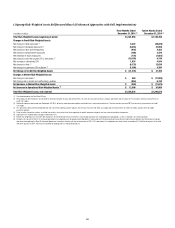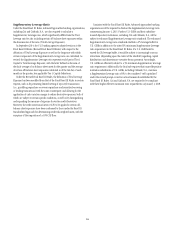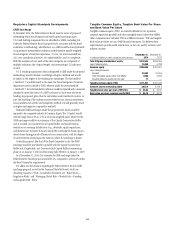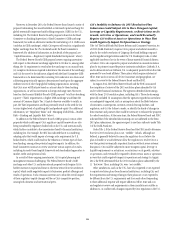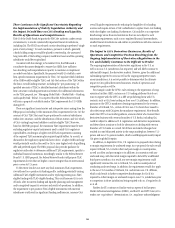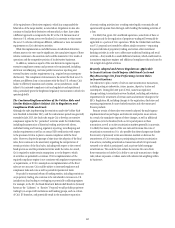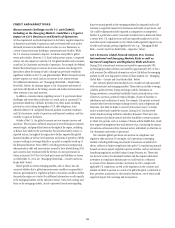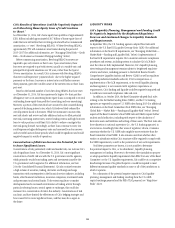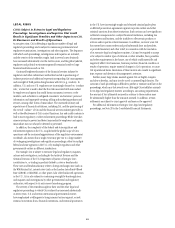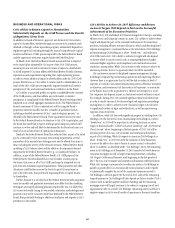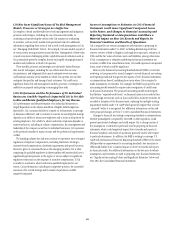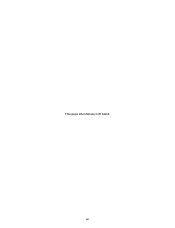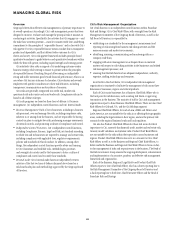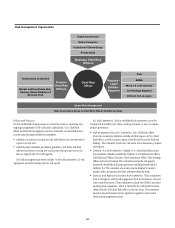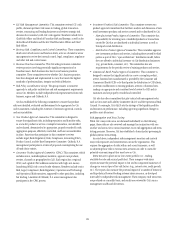Citibank 2014 Annual Report Download - page 77
Download and view the complete annual report
Please find page 77 of the 2014 Citibank annual report below. You can navigate through the pages in the report by either clicking on the pages listed below, or by using the keyword search tool below to find specific information within the annual report.60
The Maintenance of Adequate Liquidity and Funding
Depends on Numerous Factors, Including Those Outside of
Citi’s Control, Such as Market Disruptions and Increases in
Citi’s Credit Spreads.
As a global financial institution, adequate liquidity and sources of funding
are essential to Citi’s businesses. Citi’s liquidity and sources of funding can
be significantly and negatively impacted by factors it cannot control, such
as general disruptions in the financial markets, governmental fiscal and
monetary policies, or negative investor perceptions of Citi’s creditworthiness.
In addition, Citi’s cost and ability to obtain deposits, secured funding
and long-term unsecured funding are directly related to its credit spreads.
Changes in credit spreads constantly occur and are market driven, including
both external market factors and factors specific to Citi, and can be highly
volatile. Citi’s credit spreads may also be influenced by movements in the
costs to purchasers of credit default swaps referenced to Citi’s long-term debt,
which are also impacted by these external and Citi-specific factors. Moreover,
Citi’s ability to obtain funding may be impaired if other market participants
are seeking to access the markets at the same time, or if market appetite is
reduced, as is likely to occur in a liquidity or other market crisis. In addition,
clearing organizations, regulators, clients and financial institutions with
which Citi interacts may exercise the right to require additional collateral
based on these market perceptions or market conditions, which could further
impair Citi’s access to and cost of funding.
As a holding company, Citi relies on dividends, distributions and other
payments from its subsidiaries to fund dividends as well as to satisfy its debt
and other obligations. Several of Citi’s U.S. and non-U.S. subsidiaries are
or may be subject to capital adequacy or other regulatory or contractual
restrictions on their ability to provide such payments, including any local
regulatory stress test requirements or the proposed TLAC requirements (see
“Regulatory Risks” above). Limitations on the payments that Citi receives
from its subsidiaries could also impact its liquidity.
The Credit Rating Agencies Continuously Review the
Credit Ratings of Citi and Certain of Its Subsidiaries,
and Ratings Downgrades Could Have a Negative Impact
on Citi’s Funding and Liquidity Due to Reduced Funding
Capacity and Increased Funding Costs, Including
Derivatives Triggers That Could Require Cash Obligations
or Collateral Requirements.
The credit rating agencies, such as Fitch, Moody’s and S&P, continuously
evaluate Citi and certain of its subsidiaries, and their ratings of Citi
and its more significant subsidiaries’ long-term/senior debt and
short-term/commercial paper, as applicable, are based on a number of
factors, including standalone financial strength, as well as factors not
entirely within the control of Citi and its subsidiaries, such as the agencies’
proprietary rating agency methodologies and assumptions, the rating
agencies’ “government support uplift” assumptions, and conditions affecting
the financial services industry and markets generally.
Citi and its subsidiaries may not be able to maintain their current
respective ratings. Ratings downgrades could negatively impact Citi’s ability
to access the capital markets and other sources of funds as well as the costs of
those funds, and its ability to maintain certain deposits. A ratings downgrade
could also have a negative impact on Citi’s funding and liquidity due to
reduced funding capacity, including derivative triggers, which could take the
form of cash obligations and collateral requirements. In addition, a ratings
downgrade could also have a negative impact on other funding sources,
such as secured financing and other margined transactions for which there
are no explicit triggers, as well as on contractual provisions, which contain
minimum ratings thresholds in order for Citi to hold third-party funds.
Moreover, credit ratings downgrades can have impacts, which may
not be currently known to Citi or which are not possible to quantify. For
example, some entities may have ratings limitations as to their permissible
counterparties, of which Citi may or may not be aware. In addition, certain
of Citi’s corporate customers and trading counterparties, among other clients,
could re-evaluate their business relationships with Citi and limit the trading
of certain contracts or market instruments with Citi in response to ratings
downgrades. Changes in customer and counterparty behavior could impact
not only Citi’s funding and liquidity but also the results of operations of
certain Citi businesses. For additional information on the potential impact of
a reduction in Citi’s or Citibank, N.A.’s credit ratings, see “Managing Global
Risk—Market Risk—Funding and Liquidity—Credit Ratings” below.


